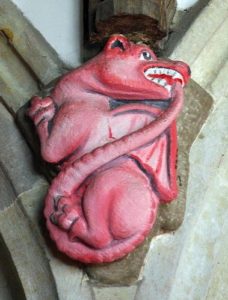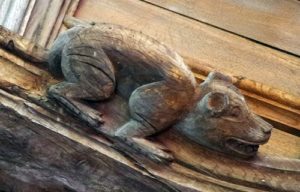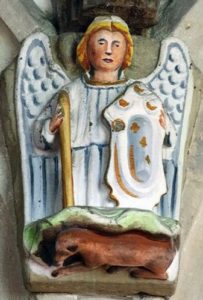This is a delightful small church built on the eastern edge of Denbigh, overlooking rich agricultural farmland to the hills beyond.
The church was built on the site of a 7thC Holy Well where the Celtic saint, Marcela, built a small church. The church became the parish church of Denbigh, although it became less important once St Hilary’s was built. St Hilary’s, near the castle, was built on solid rock and therefore unsuitable for burials, so the graveyard at St Marcella’s continued to be used. The graveyard had to be expanded twice in the 19thC. The whitewashed walls of the church acted as a landmark for travellers.
The present church dates from the 14thC and is a typical Welsh church with double nave. The square battlemented tower at the west end of the north nave is 13thC. There is a small bell cot at the west end of the south nave.
It is a big church inside with octagonal pillars with low pointed arches separating the two naves. There is a lovely 15thC hammer beam roof with painted animal heads and angels on the bottom of the beams, and more animals between the beams. Round the base of the roof is a carved frieze with red Tudor roses, domestic and exotic animals, dragons, faces, green fleur de lys… The south nave had the chapel of the Taylor’s Guild, hence the scissors in the frieze.
At the back of the church are hatchments and a large board listing all the benefactors since 1720. Another two boards list gifts of land by Robert Hughes of Kinmel Park in the 19thC to provide additional land for the graveyard.
On the north wall is a brass monument of Richard Myddleton, d1575, Governor of Denbigh Castle with his wife and their sixteen children. One of his sons, Thomas, became Lord Mayor of London and helped finance the publication of the first portable Welsh Bible. Another son, Hugh, provided London with its first efficient water supply.
Next to it is the splendid monument of Humphrey Llwyd, with his sword, kneeling in a classical temple with an arcade of round topped arches. In the arch above is a coat of arms with helms above. At the corners are angels holding a globe and a geographer's dial. He was a renowned scholar and is credited as being the 'Father of Modern Geography' as he produced the first accurate maps of Wales before his death in 1568.
A rood screen with plain base panels and tracery arches above with carvings of grapes along the top, runs across both chancels and also between them.
In Elizabethan times, the south chancel was once the private chapel of the powerful Salusbury family, hence the splendid carved communion table and altar rail. The magnificent painted alabaster monument of Sir John Salusbury and his wife Jane (a Myddleton) occupies pride of place. It records Sir John's death in 1588 but not hers. Sir John is in full armour with sword and hunting knife with his feet resting on a lion and his head on a helmet with a moor's head. Look carefully at the scabbard as it contains a tiny knife and fork set. His gauntlets lie by his side. Dame Jane wears her black funeral dress with a stiff white ruff. There are painted coats of arms at the ends and in the middle of the sides. Round the base are their children. Below Sir John are their nine sons, all dressed in armour except for one who is dressed in the black robes of a cleric. Beneath Dame Jane are their four daughters. Two are dressed in black. Two who died in infancy are shown as swaddled babies with red robes with white bands.
On the south wall is a large memorial marking the Salusbury vault and listing all the family members buried in it.
The stained glass east window is 19thC. At the top are the twelve apostle with Marcella on the left and Asaph on the right. In the centre is the risen Christ. To the left is the empty tomb with and angel meeting the two Marys. On the right is Jesus with Mary Magdalene and also as the risen Christ with two disciples.
Before leaving, notice the five copper offering dishes hanging on the wall by the door, which came from St David's Church in Denbigh.
The church is open between 9-3.30 every day. There is parking on the side road just to the east of the church. The church is accessible to wheelchair users with a slight ramp into the church. It is well worth visiting.










